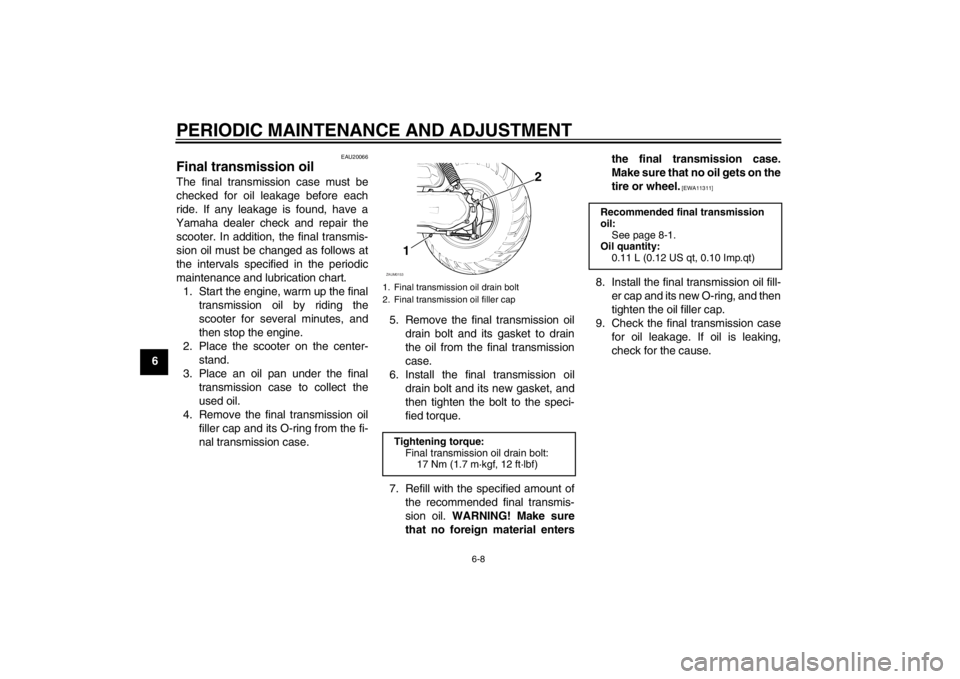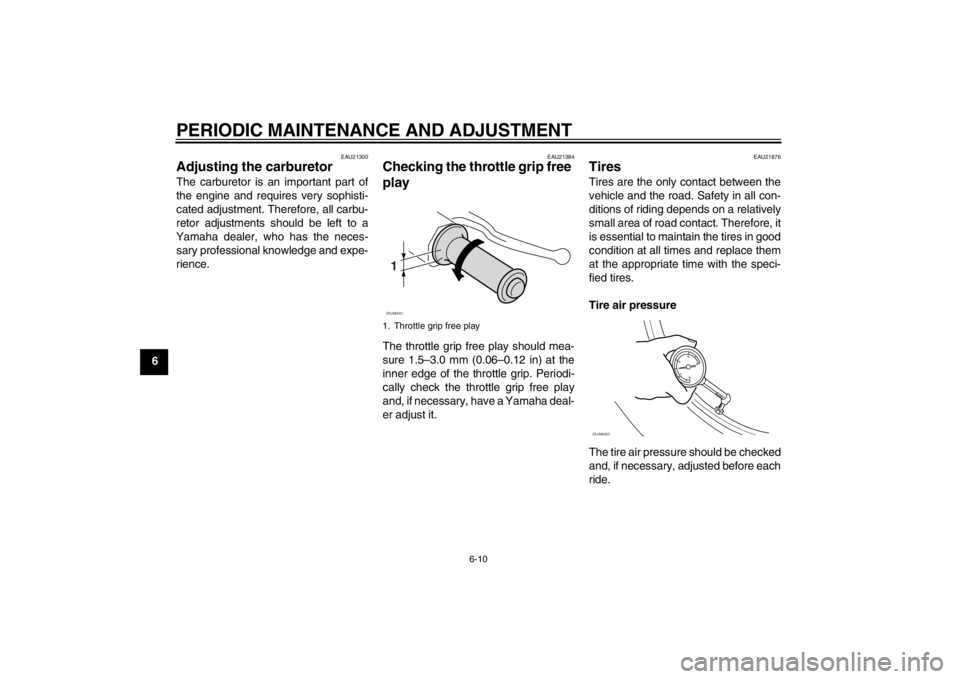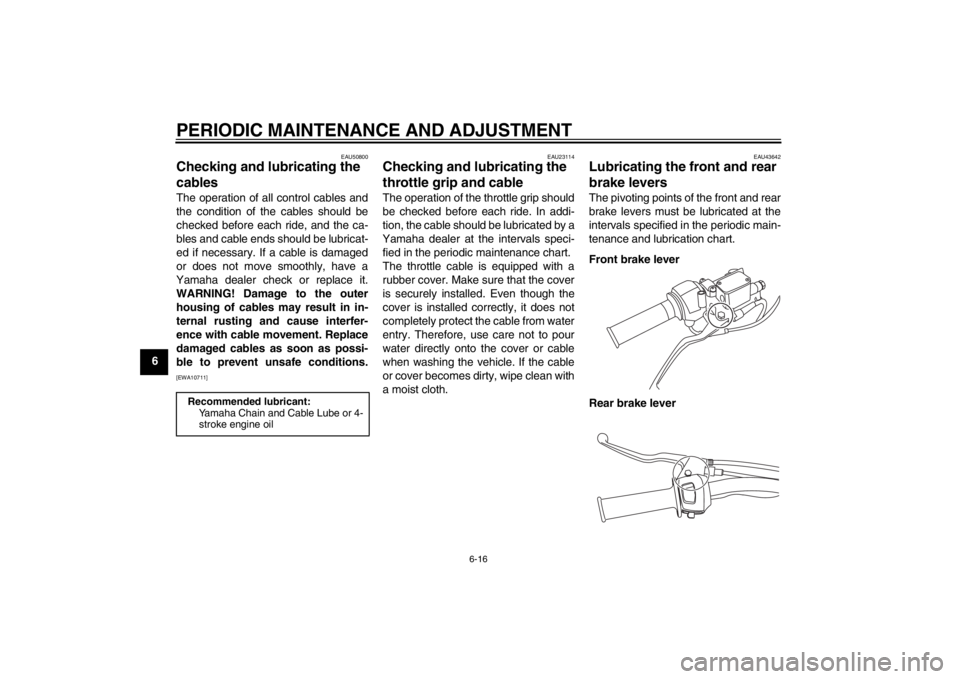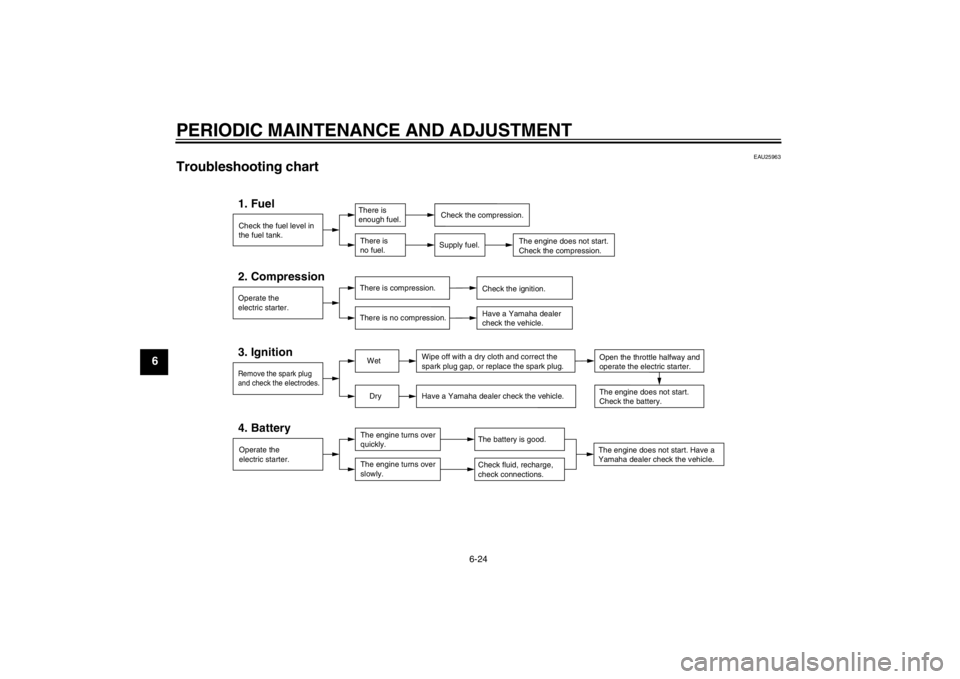check engine YAMAHA SLIDER 50 2013 User Guide
[x] Cancel search | Manufacturer: YAMAHA, Model Year: 2013, Model line: SLIDER 50, Model: YAMAHA SLIDER 50 2013Pages: 66, PDF Size: 1.58 MB
Page 40 of 66

PERIODIC MAINTENANCE AND ADJUSTMENT
6-8
6
EAU20066
Final transmission oil The final transmission case must be
checked for oil leakage before each
ride. If any leakage is found, have a
Yamaha dealer check and repair the
scooter. In addition, the final transmis-
sion oil must be changed as follows at
the intervals specified in the periodic
maintenance and lubrication chart.
1. Start the engine, warm up the final
transmission oil by riding the
scooter for several minutes, and
then stop the engine.
2. Place the scooter on the center-
stand.
3. Place an oil pan under the final
transmission case to collect the
used oil.
4. Remove the final transmission oil
filler cap and its O-ring from the fi-
nal transmission case.5. Remove the final transmission oil
drain bolt and its gasket to drain
the oil from the final transmission
case.
6. Install the final transmission oil
drain bolt and its new gasket, and
then tighten the bolt to the speci-
fied torque.
7. Refill with the specified amount of
the recommended final transmis-
sion oil. WARNING! Make sure
that no foreign material entersthe final transmission case.
Make sure that no oil gets on the
tire or wheel.
[EWA11311]
8. Install the final transmission oil fill-
er cap and its new O-ring, and then
tighten the oil filler cap.
9. Check the final transmission case
for oil leakage. If oil is leaking,
check for the cause.
1. Final transmission oil drain bolt
2. Final transmission oil filler capTightening torque:
Final transmission oil drain bolt:
17 Nm (1.7 m·kgf, 12 ft·lbf)12
ZAUM0153
Recommended final transmission
oil:
See page 8-1.
Oil quantity:
0.11 L (0.12 US qt, 0.10 Imp.qt)
U1S0E1E0.book Page 8 Wednesday, November 7, 2012 3:32 PM
Page 42 of 66

PERIODIC MAINTENANCE AND ADJUSTMENT
6-10
6
EAU21300
Adjusting the carburetor The carburetor is an important part of
the engine and requires very sophisti-
cated adjustment. Therefore, all carbu-
retor adjustments should be left to a
Yamaha dealer, who has the neces-
sary professional knowledge and expe-
rience.
EAU21384
Checking the throttle grip free
play The throttle grip free play should mea-
sure 1.5–3.0 mm (0.06–0.12 in) at the
inner edge of the throttle grip. Periodi-
cally check the throttle grip free play
and, if necessary, have a Yamaha deal-
er adjust it.
EAU21876
Tires Tires are the only contact between the
vehicle and the road. Safety in all con-
ditions of riding depends on a relatively
small area of road contact. Therefore, it
is essential to maintain the tires in good
condition at all times and replace them
at the appropriate time with the speci-
fied tires.
Tire air pressure
The tire air pressure should be checked
and, if necessary, adjusted before each
ride.
1. Throttle grip free play1ZAUM0051
ZAUM0053
U1S0E1E0.book Page 10 Wednesday, November 7, 2012 3:32 PM
Page 48 of 66

PERIODIC MAINTENANCE AND ADJUSTMENT
6-16
6
EAU50800
Checking and lubricating the
cables The operation of all control cables and
the condition of the cables should be
checked before each ride, and the ca-
bles and cable ends should be lubricat-
ed if necessary. If a cable is damaged
or does not move smoothly, have a
Yamaha dealer check or replace it.
WARNING! Damage to the outer
housing of cables may result in in-
ternal rusting and cause interfer-
ence with cable movement. Replace
damaged cables as soon as possi-
ble to prevent unsafe conditions.[EWA10711]EAU23114
Checking and lubricating the
throttle grip and cable The operation of the throttle grip should
be checked before each ride. In addi-
tion, the cable should be lubricated by a
Yamaha dealer at the intervals speci-
fied in the periodic maintenance chart.
The throttle cable is equipped with a
rubber cover. Make sure that the cover
is securely installed. Even though the
cover is installed correctly, it does not
completely protect the cable from water
entry. Therefore, use care not to pour
water directly onto the cover or cable
when washing the vehicle. If the cable
or cover becomes dirty, wipe clean with
a moist cloth.
EAU43642
Lubricating the front and rear
brake levers The pivoting points of the front and rear
brake levers must be lubricated at the
intervals specified in the periodic main-
tenance and lubrication chart.
Front brake lever
Rear brake lever
Recommended lubricant:
Yamaha Chain and Cable Lube or 4-
stroke engine oil
U1S0E1E0.book Page 16 Wednesday, November 7, 2012 3:32 PM
Page 56 of 66

PERIODIC MAINTENANCE AND ADJUSTMENT
6-24
6
EAU25963
Troubleshooting chart
Check the fuel level in
the fuel tank.1. Fuel
There is
enough fuel.
There is
no fuel.
Check the compression.
Supply fuel.
The engine does not start.
Check the compression.
Operate the
electric starter.2. Compression
There is compression.
There is no compression.
Check the ignition.
Have a Yamaha dealer
check the vehicle.
Remove the spark plug
and check the electrodes.3. Ignition
Wet
Dry
Wipe off with a dry cloth and correct the
spark plug gap, or replace the spark plug.
Have a Yamaha dealer check the vehicle.
The engine does not start. Have a
Yamaha dealer check the vehicle.The engine does not start.
Check the battery.Open the throttle halfway and
operate the electric starter.
Operate the
electric starter.4. Battery
The engine turns over
quickly.
The engine turns over
slowly.
The battery is good.Check fluid, recharge,
check connections.
U1S0E1E0.book Page 24 Wednesday, November 7, 2012 3:32 PM
Page 60 of 66

SCOOTER CARE AND STORAGE
7-4
72. Drain the carburetor float chamber
by loosening the drain bolt; this will
prevent fuel deposits from building
up. Pour the drained fuel into the
fuel tank.
3. Fill up the fuel tank and add fuel
stabilizer (if available) to prevent
the fuel tank from rusting and the
fuel from deteriorating.
4. Perform the following steps to pro-
tect the cylinder, piston rings, etc.
from corrosion.
a. Remove the spark plug cap
and spark plug.
b. Pour a teaspoonful of engine oil
into the spark plug bore.
c. Install the spark plug cap onto
the spark plug, and then place
the spark plug on the cylinder
head so that the electrodes are
grounded. (This will limit spark-
ing during the next step.)
d. Turn the engine over several
times with the starter. (This will
coat the cylinder wall with oil.)
WARNING! To prevent dam-
age or injury from sparking,
make sure to ground thespark plug electrodes while
turning the engine over.
[EWA10951]
e. Remove the spark plug cap
from the spark plug, and then
install the spark plug and the
spark plug cap.
5. Lubricate all control cables and the
pivoting points of all levers and
pedals as well as of the side-
stand/centerstand.
6. Check and, if necessary, correct
the tire air pressure, and then lift
the scooter so that both of its
wheels are off the ground. Alterna-
tively, turn the wheels a little every
month in order to prevent the tires
from becoming degraded in one
spot.
7. Cover the muffler outlet with a
plastic bag to prevent moisture
from entering it.
8. Remove the battery and fully
charge it. Store it in a cool, dry
place and charge it once a month.
Do not store the battery in an ex-
cessively cold or warm place [less
than 0 °C (30 °F) or more than 30°C (90 °F)]. For more information
on storing the battery, see page
6-19.
TIPMake any necessary repairs before
storing the scooter.
U1S0E1E0.book Page 4 Wednesday, November 7, 2012 3:32 PM
Page 64 of 66

INDEXAAcceleration and deceleration................. 5-3
Air filter element, cleaning....................... 6-9
Anti-theft device housing......................... 3-8BBattery................................................... 6-19
Brake fluid, changing ............................ 6-15
Brake fluid level, checking .................... 6-14
Brake lever, front..................................... 3-4
Brake lever, rear ..................................... 3-4
Brake levers, lubricating........................ 6-16
Brake pads and shoes, checking .......... 6-14
Braking .................................................... 5-3CCables, checking and lubricating .......... 6-16
Carburetor,adjusting ............................. 6-10
Care ........................................................ 7-1
Catalytic converter .................................. 3-6
Centerstand, checking and
lubricating ........................................... 6-17
Cowling and panel, removing and
installing................................................ 6-6DDimmer switch ........................................ 3-4EEngine break-in ....................................... 5-4
Engine oil ................................................ 3-7
Engine, starting a warm .......................... 5-2FFinal transmission oil .............................. 6-8
Front brake lever free play, checking .... 6-13
Front fork, checking .............................. 6-18
Fuel ......................................................... 3-5
Fuel and 2-stroke engine oil tank caps ... 3-5Fuel consumption, tips for reducing........ 5-4
Fuel level warning light ........................... 3-2
Fuse, replacing ..................................... 6-21
HHandlebar switches ................................ 3-3
Headlight bulb, replacing ...................... 6-21
High beam indicator light ........................ 3-2
Horn switch ............................................. 3-4IIdentification numbers ............................ 9-1
Indicator lights and warning light ............ 3-2KKickstarter............................................... 3-8LLuggage hook ......................................... 3-9MMain switch/steering lock........................ 3-1
Maintenance and lubrication, periodic .... 6-3
Maintenance, emission control system... 6-2
Matte color, caution ................................ 7-1
Model label ............................................. 9-1OOil level warning light.............................. 3-2PParking ................................................... 5-5
Part locations .......................................... 2-1RRear brake lever free play, adjusting .... 6-13SSafe-riding points.................................... 1-5
Safety information................................... 1-1
Seat ........................................................ 3-8
Spark plug, checking .............................. 6-7
Specifications ......................................... 8-1Speedometer unit .................................... 3-3
Starter (choke) lever................................ 3-7
Starting a cold engine ............................. 5-1
Starting off ............................................... 5-2
Start switch.............................................. 3-4
Steering, checking................................. 6-18
Storage.................................................... 7-3
TTail/brake light bulb, replacing .............. 6-22
Throttle grip and cable, checking and
lubricating ........................................... 6-16
Throttle grip free play, checking ............ 6-10
Tires ...................................................... 6-10
Troubleshooting .................................... 6-23
Troubleshooting chart ........................... 6-24
Turn signal indicator light ........................ 3-2
Turn signal light bulb, replacing ............ 6-22
Turn signal switch ................................... 3-4VVehicle identification number .................. 9-1WWheel bearings, checking ..................... 6-19
Wheels .................................................. 6-12
U1S0E1E0.book Page 1 Wednesday, November 7, 2012 3:32 PM